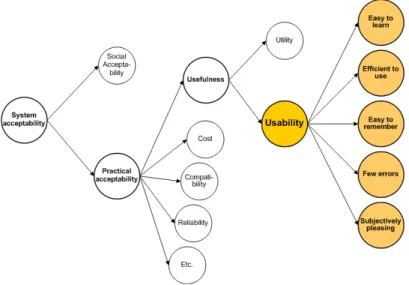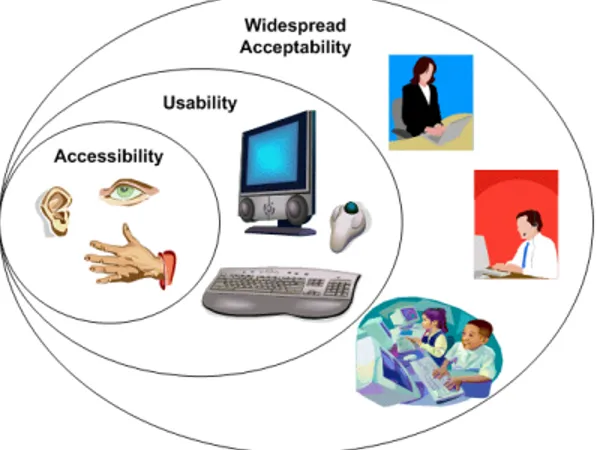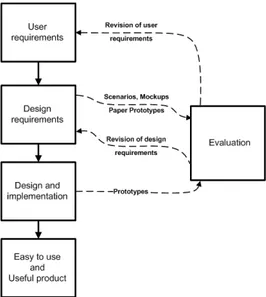Er gon om ics a n d Usa bilit y – k e y fa ct or s in
Kn ow le dge Socie t y
Isabel Lopes Nunes (imn@fct.unl.pt)
Faculty of Science and Technology, New University of Lisbon.
Abst r a ct
During the recent years human society evolved from the “industrial society age” and transitioned into the “knowledge society age”. This means that knowledge media support migrated from “pen and paper” to computer-based Information Systems. Due to this fact Ergonomics has assumed an increasing importance, as a science/technology that deals with the problem of adapting the work to the man, namely in terms of Usability.
This paper4 presents some relevant Ergonomics, Usability and User-centred design concepts regarding Information Systems.
Keywords:
Ergonomics; Usability; User-centered design
1 . I nt r oduct ion
During the recent years human society evolved from the “industrial society age” and transitioned into the “knowledge society age”. This means that knowledge media support migrated from “pen and paper” to computer-based Information Systems (IS).
This evolution introduced some technological, organizational, and methodological changes affecting the demand, work-load and stress over the workers, many times in a negative way. Due to this fact Ergonomics has assumed an increasing importance, as a science/technology that deals with the problem of adapting the work to the man, namely in terms of Usability.
Usability is then a key issue on ergonomic interventions regarding IS. Usability can be defined as a quality or characteristic of a product, denoting whether it is efficient, effective and satisfying for those who use it ISO 9241, part 11 (1998). However, Usability is also an ergonomic approach and a group of techniques aimed at creating such products, based on a user-centered design.
Currently the evolution on society and technology happens very fast, having a very high impact on work organization, and working methods. These changes have brought also some work-related problems that affect human life, like musculoskeletal disorders or stress.
En t e r pr ise a n d W or k I n n ov a t ion St u die s, N o. 2 , 2 0 0 6 I ET, M on t e de Ca pa r ica , Por t u ga l 8 8
During many generations the humans lived on a rural society. Despite the hard life, the tasks were varied, imposing different workload solicitations. With the introduction of chain production and assembly lines, there was an evolution on the demands imposed to workers. The specialization, characterized by repetitive tasks and an imposed working pace are in the origin of an increasing number of occupational diseases, caused by excessive solicitation of very few body parts. The mental load also increased, for instance because of the lack of autonomy.
On the knowledge society the physical workload apparently tends to be reduced and the workers to have a very high mental workload. In fact, the static awkward postures (for instance on the neck and shoulders), the lack of job diversity and the very high solicitation of some specific body parts (like fingers and wrists on the operation of VDU terminals) are sources of work-related disorders. On the cognitive side the demands on the workers awareness have increased, because of the volume of data to process and the need for very fast answers and decisions. These increases the workers’ stress, which is also an enabler factor of work related disorders.
This brings new dimensions and challenges to the task of designing robust and effective work systems and work environments that are healthier and safer to the workers, but always keeping in mind productivity goals (Rice, 2001). These are the main goals and concerns of Ergonomics.
2 . Er gon om ics
In very simple way Ergonomics is a way to work smarter by designing tools, equipment, work stations and tasks to fit the job to the worker, which is balancing job characteristics with human capabilities.
The word Ergonomics comes from the combination of two Greek words: ergon (meaning work) and nom os (meaning laws) to denote the science of work. It was actually first used in 1857 by Wojciech Jastrzebowski, a Polish scientist (Jastrzebowski, 2000).
Ergonomics is a systems-oriented discipline which now extends across all aspects of human activity. When practically applied, ergonomics seeks to optimize the functioning of systems by ensuring that they are compatible with human capabilities and needs.
The application of Ergonomics to job design, results on employers reduced absenteeism, increase productivity, and decreased costs for injured workers, improved union/management relations, improved morale of employees with a greater satisfaction and less stress.
The official definition of Ergonomics, by the International Ergonomics Association in 2000 was: “Ergonomics (or human factors) is the scientific discipline concerned with the understanding of interactions among humans and other elements of a system, it is also the profession that applies theory, principles, data and methods to design in order to optimize human well-being and overall system performance” (IEA, 2001).
En t e r pr ise a n d W or k I n n ov a t ion St u die s, N o. 2 , 2 0 0 6 I ET, M on t e de Ca pa r ica , Por t u ga l 8 9
Ergonomics is not really new - it only seems that way - with the new emphasis from the news media. Since pre-historic ages, human developed tools and utensils for hunting, farming, or fighting, that was effective, comfortable and easy to use.
Human motivation to understand how the human body works was also constant. The studies of the function of muscles and bones, done by Leonard da Vinci around 1400s, are a very good example of this.
Some researchers started to study the relation of man and work, either on a health or on a management perspective. For instance on the 1700s, the association between occupations and musculoskeletal injuries was documented by the physician Bernardini Ram azzini, resultant from his experience on medical practice. On the late 1800s/early 1900s Frank and Lillian Gilbret h studied the human motion and workplace management, making jobs more efficient and less fatiguing through time motion analysis and standardizing tools, materials and job process.
The interest in Ergonomics has increased during World War II, as increasingly complicated technologies were introduced into sophisticated military equipment, i.e., aircrafts. Items were placed into the aircrafts with little thought about the way the pilots or maintenance personnel would deal with such new systems. Unfortunately, the initial result was a sudden increase of accidents and the subsequent loss of life’s. Maintenance issues also became more complex, and aircraft turnaround increased. It gradually became clear that systems and products would have to be designed to take account of many human and environmental factors if they are to be used safely and effectively. This awareness of people’s requirements resulted in the discipline of ergonomics, which was officially born in England the 1949, 12th July.
2 .1 Er gonom ic in t e r ve n t ion a r e a s
Ergonomics addresses the work related problems from different perspectives, which comprise the main Ergonomics domains, i.e. Physical, Cognitive and Organizational Ergonomics (IEA, 2006).
Physical ergonomics is concerned with the human body's responses to physical and physiological loads. Relevant topics include manual materials handling, workstation layout, job demands, and risk factors such as repetition, vibration, force and awkward/static posture as they relate to musculoskeletal disorders.
Cognitive ergonomics, also known as engineering psychology, concerns with mental processes such as perception, attention, cognition, motor control, and memory storage and retrieval as they affect interactions among humans and other elements of a system. Relevant topics include mental workload, vigilance, decision making, skilled performance, human error, human-computer interaction, and training.
Organizational ergonomics, or macroergonomics, is concerned with the optimization of sociotechnical systems, including their organizational structures, policies, and processes. Relevant topics include shift work, scheduling, job satisfaction, motivational theory, supervision, teamwork, telework and ethics.
En t e r pr ise a n d W or k I n n ov a t ion St u die s, N o. 2 , 2 0 0 6 I ET, M on t e de Ca pa r ica , Por t u ga l 9 0
To achieve that the Ergonomic design should lay down in the following six pillars (Sanders and McCormick, 1993):
1. User Orient at ion: Design and application of tools, procedures, and systems
must be user-oriented, rather than just “task” oriented;
2. Div ersit y: Recognition of diversity in human capabilities and limitations, rather than “stereotyping” workers/users;
3. Effect on Hum ans: Tools, procedures, and systems are not “inert”, but do
influence human behavior and well-being;
4. Obj ect iv e Dat a: Empirical information and evaluation are key factors in the
design process, rather than just using “common sense”;
5. Scient ific Met hod: test and retest hypothesis with real data, rather than
“anecdotal” evidence or “good estimates”;
6. Syst em s: object, procedures, environments, and people are interconnected,
affect one another, and do not exist in “isolation”.
3 . Kn ow le dge Socie t y
In the Knowledge Society computers and other intelligent digital equipment became more and more widespread. Computers, mobile computing associated, for instance, with cell phone terminals, and robotic equipment are used by all ages throughout the workforce.
They are used at work, at school and at home. It could be said that the computer and related equipment have become today’s most used tools. This new information technology has erased the boundaries of the workplace, as people can easily continue to work at home or elsewhere. Technology makes it possible workers to be accessible anywhere, day and night.
However not all equipment are designed having in mind a simple and efficient use. Many equipment and interfaces are just too difficult to use and to understand.
The famous "12:00" blinking of VCRs became a symbol of bad user interfaces. Usually for setting time on a VCR the sequence of operations is so hard to figure and reading the manuals is the last thing one wants to do, that most people don’t even bother to set the time. This is a typical problem of lack of Usability on equipment.
4 . Usa bilit y
Usability is a quality or characteristic of a product that denotes how easy this product is to learn and to use (Dillon, 2001); but it is also an ergonomic approach, and a group of principles and techniques aimed at designing usable and accessible products, based on user-centered design.
According to ISO 9241, part 11 (1998), Usability is defined as the effectiveness, efficiency and satisfaction with which specific users achieve goals in particular environments. It applies equally to both hardware and software design. The definitions of the three key terms are:
- Effect iv eness is the accuracy and completeness with which specific users
En t e r pr ise a n d W or k I n n ov a t ion St u die s, N o. 2 , 2 0 0 6 I ET, M on t e de Ca pa r ica , Por t u ga l 9 1
- Efficiency is the resources expended in relation to the accuracy and
completeness of goals achieved; and
- Sat isfact ion is the comfort and acceptability of the system to the users and
other people affected by its use.
The lack of care about users needs can lead to solutions tend to cause errors or that provide users with inadequate information. Many examples of such situations on daily life can be presented, and there are some websites that demonstrate problematic situations and propose some simple solutions to solve them. Refer, for instance, to the following websites: “Bad Human Factors Designs”; “General Principles of WWW Usability” or “An example of good and bad usability design”.
It is important to realize that usability is not a single, one-dimensional property of a user interface. Usability has multiple components and is traditionally associated with these five usability attributes: learnability, efficiency, memorability, errors, satisfaction (see Figure 1) (Nielsen, 1993).
Figure 1 - Attributes for Assessing Usability
Adequate Usability is important because it is a characteristic of a product’s Quality that leads to improving product’s acceptability, increasing users’ satisfaction, improving products’ reliability and it is also financially beneficial to companies. Such benefit can be seen from 2 points of view, one related with workers’ productivity (less training time and fastest tasks completion), and the other with product sells (products easier to sell and products market themselves, when users had positive experiences).
En t e r pr ise a n d W or k I n n ov a t ion St u die s, N o. 2 , 2 0 0 6 I ET, M on t e de Ca pa r ica , Por t u ga l 9 2
5 . Use r - ce nt e r e d de sign
An approach for employing usability is User-centered design (UCD). UCD is an approach which focuses on users from the very beginning of the development process (Figure 2). By adopting this approach it is possible to develop more useful and easy to use applications and systems. It is known that many products are not accessible to large sections of the population. Designers instinctively focus on providing the necessary utility for someone with their physical and skill capabilities. They are either unaware of the needs of users with different capabilities, or do not know how to accommodate their needs into the design cycle (Clarkson and Keates, 2003). Usability engineering techniques exist that broadly extend the skill range of potential users, and accessibility techniques for physical capabilities. However, approaches for combining all three are rare (Keates and Clarkson, 2001).
Figure 2 – User-centered design
User-centered design is a structured product development methodology that involves users throughout all stages of product development, in order to create a product that meets users' needs (Averboukh, 2001).
According to ISO 13407 (1999) there are four essential user-centered design activities which should be planned for and undertaken in order to incorporate usability requirements into the development process (see Figure 3). The activities look for:
• understanding and specifying the context of use;
• specifying user and organizational requirements;
• producing designs and prototypes; and
• carrying out user-based assessments.
En t e r pr ise a n d W or k I n n ov a t ion St u die s, N o. 2 , 2 0 0 6 I ET, M on t e de Ca pa r ica , Por t u ga l 9 3
Figure 3 - User-centered design activities
6 . Con clu sion s
The evolution from the Industrial Society to the Knowledge Society brought new technological, organizational, and methodological issues which affect, many times in a negative way, the demands over the workers, like the workload and the stress.
To overcome these negative effects it is important to consider some basic Ergonomics’ guidelines that help to adapt work to human capabilities. One key concern relates with Usability concepts.
Usability can be defined as a quality or characteristic of a product, denoting whether it is efficient, effective and satisfying for those who use it. However, Usability is also an ergonomic approach and a group of techniques aimed at creating such products, based on a user-centered design.
User-centered design is a structured product development methodology that involves users throughout all stages of product development, in order to create a product that meets users' needs, is useful and easy to use.
7 . Re fe r e n ce s
Averboukh, E.A., 2001. Quality of Life and Usability Engineering, in I nt er nat ional Encyclopedia of Ergonom ics and Hum an Fact ors, W. Karwowski (ed), Taylor & Francis, p. 1317-1321
Clarkson, P.J. and Keates, S., 2003. User capabilit ies and pr oduct dem ands, in http://rehab-www.eng.cam.ac.uk/papers/include2003/capdem.htm
Dillon, A., 2001. Evaluation of Software Usability, in I nt ernat ional Ency clopedia of
Er gonom ics and Hum an Fact ors, W. Karwowski (ed), Taylor & Francis, p.
1110-1112
En t e r pr ise a n d W or k I n n ov a t ion St u die s, N o. 2 , 2 0 0 6 I ET, M on t e de Ca pa r ica , Por t u ga l 9 4
IEA, 2001. IEA Definitions of Ergonomics, in I nt er nat ional Encyclopedia of Er gonom ics and Hum an Fact or s, W. Karwowski (ed), Taylor & Francis, p. 102
IEA, 2006. The discipline of Ergonomics, I nt ernat ional Ergonom ics Associat ion, in
http://www.iea.cc, ( accessed 4Oct 2006)
ISO 9241, 1998. Ergonomic requirements for office work with visual display terminals (VDTs) – Part 11: Guidance on Usability.
ISO 13407, 1999. Human-centred design processes for interactive systems
Jastrzebowski, W., 2000. An Out line of Er gonom ics, or t he Science of Work based on t he t rut hs draw n from t he Science of Nat ure 1857. Central Institute for Labour Protection.
Nielsen, J., 1993. Usabilit y Engineering. Academic Press.
Rice, V.J., 2001. Medical Equipment Usability Testing: an Introduction, in
I nt ernat ional Encyclopedia of Ergonom ics and Hum an Fact ors, W. Karwowski
(ed), Taylor & Francis, p. 1859-1863
Sanders, M.S. and McCormick, E.J., 1993. Hum an Fact ors in Engineering and Design. McGraw-Hill, Inc.
List s of Usa bilit y lin k s
“An example of good and bad usability design” - http://www.eirikso.com/2005/06/16/an-example-of-good-and-bad-usability-design/
“Bad Human Factors Designs” - http://www.baddesigns.com/
“General Principles of WWW Usability” -


